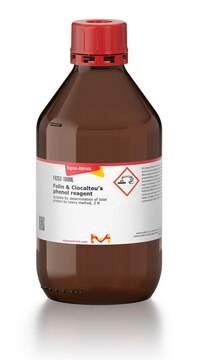262919
Tantal
foil, thickness 0.025 mm, ≥99.9% trace metals basis
Synonym(e):
Ta
About This Item
Empfohlene Produkte
Dampfdruck
<0.01 mmHg ( 537.2 °C)
Qualitätsniveau
Assay
≥99.9% trace metals basis
Form
foil
Selbstzündungstemp.
572 °F
Widerstandsfähigkeit
13.5 μΩ-cm, 20°C
Dicke
0.025 mm
bp
5425 °C (lit.)
mp (Schmelzpunkt)
2996 °C (lit.)
Dichte
16.69 g/cm3 (lit.)
SMILES String
[Ta]
InChI
1S/Ta
InChIKey
GUVRBAGPIYLISA-UHFFFAOYSA-N
Allgemeine Beschreibung
Menge
Lagerklassenschlüssel
11 - Combustible Solids
WGK
nwg
Flammpunkt (°F)
Not applicable
Flammpunkt (°C)
Not applicable
Persönliche Schutzausrüstung
Eyeshields, Gloves, type N95 (US)
Analysenzertifikate (COA)
Suchen Sie nach Analysenzertifikate (COA), indem Sie die Lot-/Chargennummer des Produkts eingeben. Lot- und Chargennummern sind auf dem Produktetikett hinter den Wörtern ‘Lot’ oder ‘Batch’ (Lot oder Charge) zu finden.
Besitzen Sie dieses Produkt bereits?
In der Dokumentenbibliothek finden Sie die Dokumentation zu den Produkten, die Sie kürzlich erworben haben.
Kunden haben sich ebenfalls angesehen
Artikel
Can there be an effective strategy for finding breakthrough materials, since they are, by definition, unpredictable? One answer is found in Combinatorial Materials Science techniques, which represent a powerful approach to identifying new and unexpected materials.
Biomedical implants are essentially foreign substances within the human body that must survive many years’ exposure to demanding mechanical and physiological conditions. Despite these challenges, metal implants have been widely used to substitute for or rebuild hard tissues such as bones and teeth.
Unser Team von Wissenschaftlern verfügt über Erfahrung in allen Forschungsbereichen einschließlich Life Science, Materialwissenschaften, chemischer Synthese, Chromatographie, Analytik und vielen mehr..
Setzen Sie sich mit dem technischen Dienst in Verbindung.






